CANADA GEESE TROUBLESHOOTING
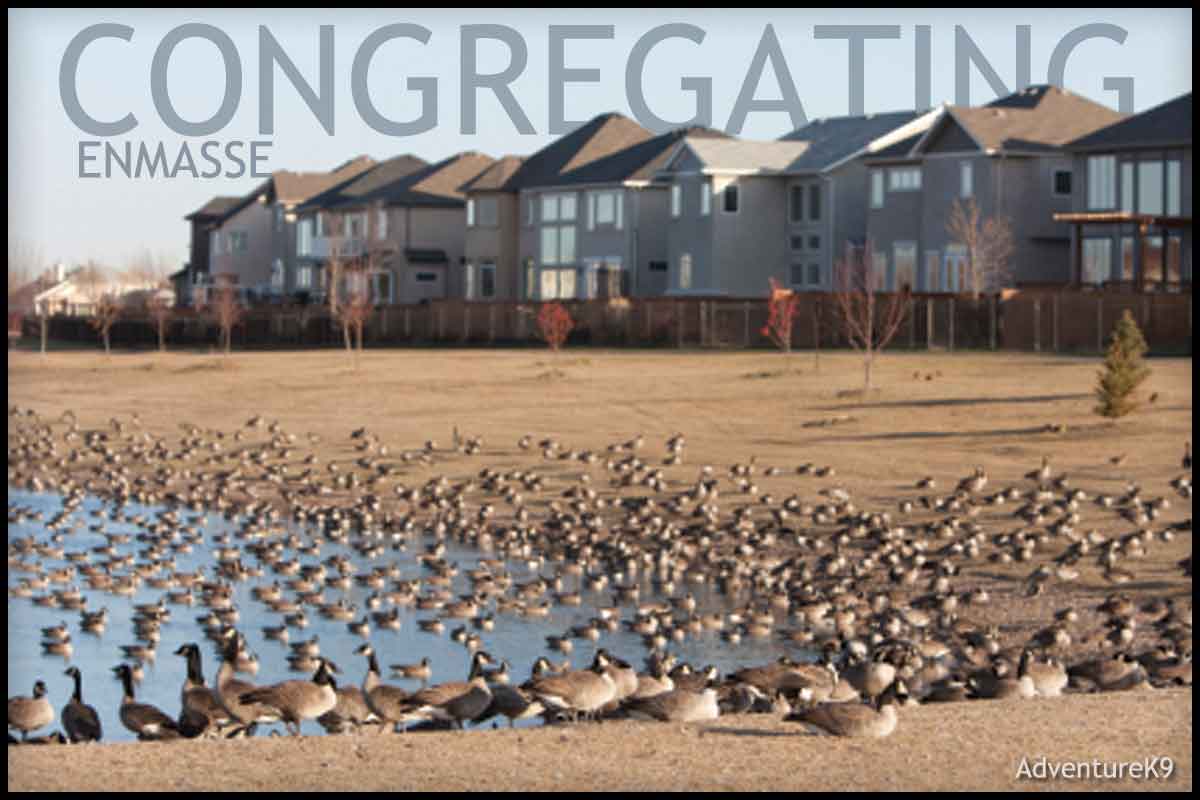
The Canada Goose. By nature an amazing migratory waterfowl bird. Striking in looks, with a number of fascinating traits, and interesting characteristics. The problem, however, is in the birds natural flocking instincts to emass into large communal numbers, its taste for manicured grass, and its bold decision to take up residence within the same green space environments that we live, work and play. Co-existing amongst large numbers of geese presents enormous problems.
The increase in numbers of Canada geese throughout North America over the past two and a half decades has reached alarming levels and continues to cause major problems where people and these birds co-exist. The underlying problem across southern Ontario is that we have a new distinct population of Canada geese known as 'resident geese'. This means they no longer migrate, choosing instead to live year round within the territory they were hatched in. The numbers of resident geese have exploded since every generation hatched here stays here. And where they were hatched is where they will nest, known as 'imprinting' and is why properties often experience a dramatic rise in numbers over a few short years. Add to that the fact that Canada geese can live up to and beyond 20 years, start breeding between the ages of 2 - 3 and are known for large clutch numbers and low mortality rates. It quickly becomes apparent why the resident population has grown so rapidly.
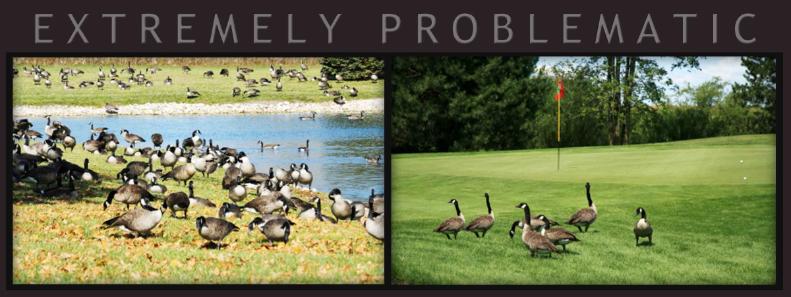
Grazers by nature, geese seek out well manicured properties with nutritious short grass feeding
opportunities. Because they are social birds they naturally flock together emassing at times into
massive congregations. This can have a devasting impact on turf in terms of aggressive feeding
and excessive defication.
Defication
As a grazing bird, geese spend a large portion of their day feeding. A grass/grain diet produces excessive amounts of fecal matter, accumulating to an estimated 1.5 - 2 lbs per goose per day! Multiplied by large numbers of birds, this creates an overwhelming amount of fecal matter on a daily basis, creating the potential of a health risk where people and geese co-habitat.
Research has shown that the excrement of geese contains a wide variety of pathogens capable of infecting humans. (Diseases transmitted from animals to humans are known as zoonotic diseases). Yet geese can also be a means of transmitting (vector) other diseases in ways unrelated to their defecation. As goose numbers continue to increase, concerns have been raised regarding the negative impact Canada geese may have on water quality and disease transmission (Fallacara et al. 2001).
Canada geese presence at parks and golf courses raised the question of the potential of disease transmission to humans via contact with goose droppings (Converse et al. 1999). The droppings of Canada geese have been found to carry a significant number of diseases, some of which are of significant concern to humans.(excerpt from the Internet Centre for Wildlife Damage Management) http://icwdm.org/handbook/birds/CanadaGeese/HumanHealth.aspx
Other major problems associated with excessive waste matter include accidents due to slipping, tracking the excrement from parking lots, sidewalks and sportsfields into indoor home, workplace or professional settings, clogged and soiled turf equipment, litterred and unputtable greens and highly unsightly conditions in manicured settings, to name a few.
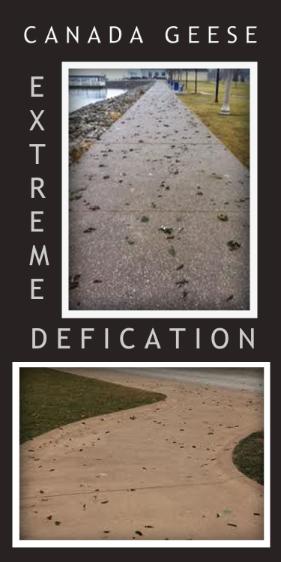
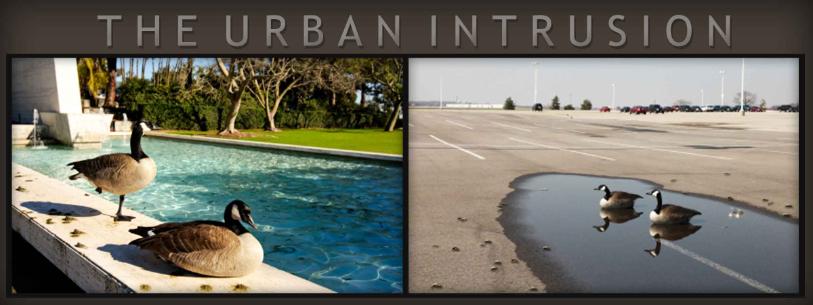
**IMPORTANT - BE ADVISED
NEST CONTROL - When it comes to nest control and nesting pairs, Canada geese are federally protected and it is against the law under the Migratory Bird Act to touch, damage, remove or destroy a Canada goose nest or the eggs without the authorization and application of a Nest Damage Permit issued thru the Canadian Wildlife Services. AdventureK9 facilitates the lengthy application process obtaining all relevant and necessary permits and keeps detailed nesting records on every property. AdventureK9 provides detailed reports back to the Canadian Wildlife Service in conjunction with the mandatory permit reporting forms.
Danger
While much of the damage associated with Canada geese is due to excessive excrement or turf damage from aggressive feeding, during the spring nesting months geese can become extremely aggressive in defending their chosen nesting territory or nest site. This, coupled with the fact that urbanized resident geese often choose nest sites in busy urban environments, including on and around busy walkways, parking lots and buildings. The result is often outright attacks from aggressive ganders on unsuspecting pedestrians. Adult ganders are strong birds with powerful wingbeats weighing as much as 18 lbs and could easily injure an unsuspecting person, especially a child or senior citizen with an unprovoked attack when in vicinity of their nest or goslings. Incubation time of their eggs is approximately 28 days plus the weeks they guard their nesting territory prior to mating means that a pair of nesting geese can pose a threat of danger for 2 - 3 months ( March - May ). The pair remains extremely defensive of their brood once hatched, and will attack aggressively any perceiveable threat.
Turf Damage
Geese can be aggressive feeders, prefering to feed on the new growth of manicured grass, such as found on golf courses, sports fields, parks and cemetaries. Aggressive feeding can have devastating effects on bentgrass golf greens and lawnbowling arenas, particularly with a sand base as entire plugs of grass are pulled out by the roots. Geese are also attracted to the sand bunkers and beaches, eating the sand to assist with digestion and leaving the bunkers soiled with feces and tracks.
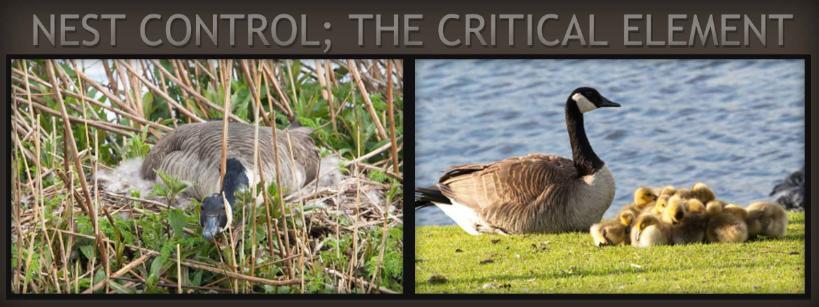
Goslings and the Molt
Adult geese choose nesting sites on or near suitable rearing environments that have adequate food and water to raise their goslings. Ideal environments include manicured greenspace with direct access to deep still or slowmoving waterways. Often these nursery type environments attract multiple families to raise their broods together, known as 'gangbrooding'. This type of situation can have disastrous effects, creating excessive waste, damage to turf, and the goslings being 'imprinted' to the area, choosing instictively to raise their own clutch in the same nursery upon breeding maturity.
Adult geese molt their flight feathers each year in conjunction with the goslings being hatched and reared. This means both adults and goslings remain in the 'flightless stage' on your property, grounded there for 7 - 10 weeks untill capable of flight.
Noise
Canada geese are a very vocal bird. This combined with their tendency to emass into large flocks causes a serious issue with noise where homes or apartments are nearby. Noise from flocking geese can be an issue throughout the year, however, springtime may be among the worst, as geese are continually sounding off in territorial disputes
Geese are resiliant, persistant birds. When they find an area that is to their liking and meets their physical needs, such as feeding, roosting, nesting, safety and adaquate water sources, it can be very difficult to deter them.
AdventureK9 Goose Control has the experience and the proven field tactics to take back your property from the destructive nature of Canada geese. Within our program we can develop a strategy for your property guaranteed to be effective in humanely forcing the birds out and ensuring it stays that way.
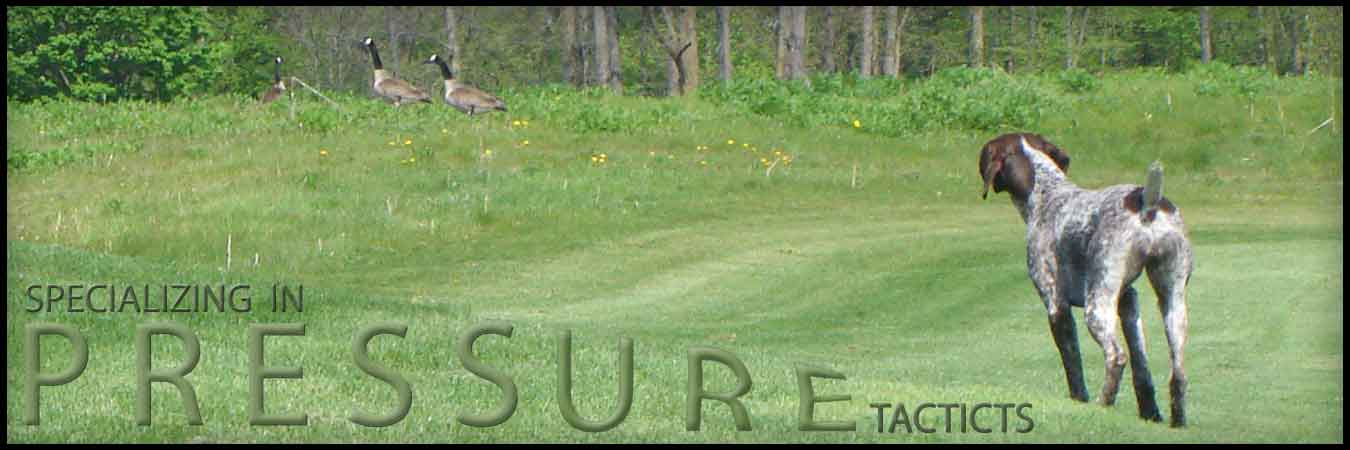
AdventureK9 g o o s e c o n t r o l